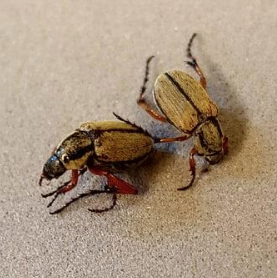
Rose Chafer, Macrodactylus subspinosus
Rose Chafers are out in full swing right now, munching on, and often times, skeletonizing many landscape and garden plants. Adult beetles are most attracted to flower blossoms, particularly rose and peony. Damage often occurs in June, and tends to be most severe in areas with sandy soil, which is preferred by the larvae. Heavy or clay soils hamper growth and development of the beetles. Listed below are some methods of control for these pesky insects!
Control
Cultural: Only a few insects are needed to do a great amount of damage. In a small gardens it can be practical to remove the beetles by hand from plants. These should be crushed or destroyed, as the beetles are strong fliers and can reinvade from surrounding areas. Placing cheese cloth or other light covering over the plant before infestation can work as a preventative.
Chemical: If the insect is present during the period of damage, acephate, bifenthrin, carbaryl, cyfluthrin, deltamethrin, imidacloprid, lambdacyhalthrin, and peremethrin are the most effective ingredients in chemical controls. For large populations, two to three applications may be necessary. Re-infestation can readily occur during heavy flights, and insecticide applications may not completely protect the plants. Be certain to read and follow all precautions and instructions on the pesticide label before use.
For more information visit https://hort.uwex.edu/articles/deciduous-tree-and-shrub-disorder-skeletonizing-by-rose-chafer



